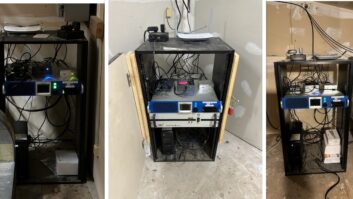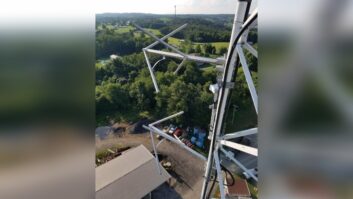WZIP-FM is on the Right Track
Jul 1, 2012 1:00 AM, By Blake Thompson, CBNT
WZIP-FM started life as WAUP in 1962 at the University of Akron campus, and was run primarily as a student club for the next 17 years. In 1979 a new general manager, Tom Beck, was hired and proceeded to make major changes at the station. One of which was to hire additional engineering help, and in 1980 I was added to the staff. The changes started moving even faster after that; the focus changed to become a professional broadcast training program. I was named chief engineer in 1982 just as we were beginning to look for more power and height. We began with a move from 80′ on campus to 800′ on a new tower built by the public TV consortium for Northeast Ohio. We originally transmitted at 330W, but soon upgraded to a directional antenna system and an increase in power to 3.3kW ERP in 1985. This really kick started the program as we could now be heard over most of the area from which the University draws students. We had one more upgrade in 1997 as other stations changed frequency so we could increase to 7.5kW ERP.

Main air studio now
We are a different kind of college station than most. There are three full-time employees: the GM, the secretary and me. Everything else is done by the students, all underwriting sales, promotions, music directors, news, sports, and of course the announcers. Tom Beck is a tremendous motivational speaker and teacher; it is his leadership and drive that has made WZIP the highest-rated student-run station in the country. The administration sees the promotional value of the work the student announcers talking to our 120,000 plus weekly listeners about the great opportunities at the University of Akron during every shift, so much so that they found $175,000 for infrastructure upgrades for WZIP and the companion Z-TV program. To accomplish all we wanted to do we also used money raised from underwriting. The idea was to replace most of the big equipment installed in our last major upgrade when we moved to our current 3,100-square-foot space in 1997/1998.

Main air studio before
Start in the studios
First up came the Axia iQ consoles to replace the analog Airwaves that, while still working well, are looking all of their 14 years old. I wanted an audio-over-IP system, and with my proximity to Cleveland and seeing the Axia consoles evolve at various SBE meetings and conferences over the years they were an easy choice. If you’re planning an installation such as this, take time ensure you have the StudioHub adapters and ancillary outboard equipment to get the job done.
I was able to run the initial setup through the Axia Web control quite quickly with the only challenge being the hybrid/codec foldback and Livewire settings. One of the big advantages of all the IP consoles are the Profiles, which allow different settings based on which show is going on. We use all four profiles in the iQ: one for the standard broadcast with mics, phones, and the Enco automation system we’ve been working with since 1995. Then we have a sports profile for the games and talk shows we run. We also have a profile for our weekend Polka show. (Don’t laugh – it has the highest AQH shares of any show we broadcast.) That uses two CD players, a feed from a laptop and the occasional track from vinyl. My fourth profile is set up with carts and CDs as sources with only the main automation output, just in case we have Windows issues.
– continued on page 2
WZIP-FM is on the Right Track
Jul 1, 2012 1:00 AM, By Blake Thompson, CBNT
The iQs were installed in our main on-air studio and the backup on-air 2 studio. I actually configured on-air 2 first so I could train the announcers in a low-stress environment. I have the same profiles in both except the last one in on-air 2 is geared for use as a production studio.

The new backup air studio/production 2 is centered around an Axia iQ and Enco DAD system.
The main production training room has an Audioarts R-60 console and enough space for six to eight students and their student teacher. In our program our best current students train the next wave. We also have a small production studio with an Allen & Heath XB-14 console. All the studios have an Enco workstation on a KVM, Adobe Audition, Audio-Technica mics, CD players and recorder, and a few lesser-used items like turntables and carts.

The training/production studio 1 has an Audioarts R-60 and Adobe Audition.
The installation went smoothly and much quicker than the last console installs. The StudioHub adapters, Krone blocks, and CAT-5 patch assemblies are the only way to go in today’s market. I had limited student help but it was still all done in about a week. The training process went well too; even our mature Polka show volunteers liked the new setup.
I had a few holes to fill in the tabletop since the iQ footprint is quite a bit smaller than the old consoles. The only complaint I had was from the graduating class who didn’t get a chance to use the new equipment.
– continued on page 3
WZIP-FM is on the Right Track
Jul 1, 2012 1:00 AM, By Blake Thompson, CBNT
STL connections
I wanted a Harris HD Link to be a drop-in replacement for our old CD Link, but I also wanted full IP network capability at the transmitter site since I can’t seem to even get DSL there. I decided a set of Mosley Lanlinks, with diplexers to add the full-duplex IP traffic onto the 950MHz signal, would fit the bill. The HD Link came in first, so I started to bench test it into a 20W load. While moving the receive unit to the bench I heard something rolling around in the case. This usually is not good news, and it wasn’t. The culprit was a small, stray nut, but there was no screw to be found. On power up I could set the frequency/bandwidth, but the unit would not lock onto a good signal. It was stuck in the acquiring mode. A call to Harris tech support and a new unit fixed the issue, but I’m sure glad I did the bench test. I was able to get them set up in just a few minutes using the on-screen menus and the Web access pages to check errors etc. One thing I really like is the ability to set levels inside the units, something the older units couldn’t do.

The interview studio with an Allen & Heath XB-14 console has custom-built furniture.
When I received the Mosley Lanlinks I went through the serial port setup. I was able to set the power level and static IP and pop them in the rack. For the final install I had to wait for some help from my friend Rick Kent, who handles the School of Communication engineering. Once we were set at both ends I switched the program feed to the Tielines and traded out the cables. On power up they both booted and worked fine. I still had to get some settings right for the RBDS system, but the audio was great. The LanLink’s speed was good enough for email at the transmitter site but seemed a little slow loading Web pages. I ran a speed test from my laptop and it came up with 550kb/s for download speed and 375kb/s for uploads. That is comparable to low-grade DSL service and quite acceptable for my needs.
To the transmitter
The transmitter required a full bid process, and we sent them to the three largest manufacturers. The Nautel NV-5 came back as the low bidder, which was my first choice anyway. I scheduled the removal of the old QEI backup to be placed on the roof for later use as an aux site. The crew arrived with a forklift on a second truck and the QEI was moved without much trouble at all. The Nautel came in crated, and the crew had a lift gate and pallet truck to move the crate. I was fortunate to have Gary Liebisch of Nautel on hand to assist with the un-crating and installation.

The computer and wiring interconnect room houses the Enco workstations, Buffalo and Netgear NAS servers, Telos Profiler and Invonics modulation monitor.
I had the ac power lines ready to go, but had to change some of the RF plumbing to get to the NV-5 outlet. At the end, Liebisch and I were both pushing with all we had to get that last nut past the flange and tightened down. We connected the composite from the Omnia One and powered it into the dummy load while I had my training. The touchscreen interface is really great, and I see why it won awards when introduced a few years ago. We run a radio reading service on 67 kHz and I could see just where the insertion level was relative to the pilot and RDS.
– continued on page 4
WZIP-FM is on the Right Track
Jul 1, 2012 1:00 AM, By Blake Thompson, CBNT
When I switched the NV on to the Shively directional antenna system the reflected power actually dropped to 8W from the 16W it had on the load. Obviously the antenna is well tuned but I know the more than 800′ of transmission line helps some too. One quirk in the NV AUI is when you log in through the Web and enter your user name it pops up a touch keyboard on the screen, but you can hit esc and it’s back to normal.

At the transmitter site, the main transmitter is a Nautel NV-5 with a Harris Z5CD backup.
Now I’m able to access all of the equipment at the remote site through the Net, and the new transmitter logs look great with a screen cap of the main Nautel display page. The only drawback was the delay in the audio from adding the STL link and Axia IP audio path. It wasn’t too much in each unit, but add that to the slight delay in the Omnia and it was just enough to throw the announcers off.
I handled this by changing the source for the headphone feed to an analog processed feed before the STLs and all was well. It was a busy month or so but very well worth it and I’m now back to having the same type of equipment as the stations our graduates may be working on in their future jobs.
Equipment list
Audemat FMB80
Audio-Technica AT2035
Axia iQ, Core, analog nodes
Enco DAD, Rama
Harris HD Link
Mosley LanLink HS 900
Nautel NV-5
Omnia One
Radio Systems StudioHub+
Telos HX-1
Thompson is chief engineer of WZIP, Akron, OH.
July 2012
AVB for radio, a tour of WZIP-FM, update on translator rules, and Field Reports on the Inovonics David IV and Audio-Technica AT2005USB…












